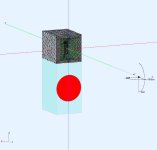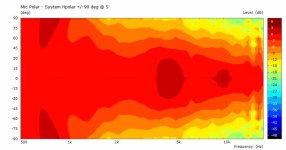After thinking about it, why not? Tempted to combine the DE250 to the "constant directivity" horn from Aliexpress (how should we call this horn? this is too long). Apparently the exit angle (included) of the DE250 is like 13 degrees. What would this mean for the performance of the combo?. IMO you should use a compression driver with this horn.
I was thinking about using AKABAK to simulate several different exit angles, by using the normal-driving function and a 1 inch dome shape that mimics the sound wave coming from the driver exit. The "normal" driving simulates a mesh that "breathes" in the normal direction of the triangles that are driven.
If a compression driver (CD) is used, and the XO >1.5Khz, then all that's required is a smooth response. It's optimum to match the exit angle but it's not significant when they do not match. The consequence is a possible reflection from the acoustic impedance mismatch due to flare rate differences. Any gaps or ledges in the matting surface or throat interface are real problems.
I suggest calling the horn "DiffSlotHF" just because its a "Diffraction Slot HF" design. IIR I think it might be a clone of a Beyma horn. In Akabak the driver membrane radiates, by default, normal to the triangles. However, you can also specify a radiation direction that overrides that default, usually in an axis direction, that's useful for deep drivers like a cone.
I suggest calling the horn "DiffSlotHF" just because its a "Diffraction Slot HF" design. IIR I think it might be a clone of a Beyma horn. In Akabak the driver membrane radiates, by default, normal to the triangles. However, you can also specify a radiation direction that overrides that default, usually in an axis direction, that's useful for deep drivers like a cone.
I have ordered and received celestion cdx1-1747 CD drivers for the HF. I looked for some distortion measurements for determining how low i could XO to the woofer. This is what i found.
Because the driver would be used with a smaller horn than in the post and will be used in a home environment, i think the XO can be at 1kHz. This will be evaluated with (distortion) measurements.
I simulated DiffSlotHF on a baffle/box 210mm wide with 10mm roundovers on the vertical edges like on the renderings of past posts. still need to do the vertical assessment.

past 10k it's a mess. Curious what the real life normalized measurements will show!
The woofer selection needs to be evaluated on beam with because of the new knowledge on the directivity of DiffSlotHF mounted on a baffle. This to ensure a good matching beam with.
Would love to hear your $0.02!
PS: 1st post of the thread has been updated to show the current status
Because the driver would be used with a smaller horn than in the post and will be used in a home environment, i think the XO can be at 1kHz. This will be evaluated with (distortion) measurements.
Here is the other half of the midrange!Constant directivety is not really possible with such a small horn. Well, it can be in the range of 2 ... 20 kHz, but what about the other half of the midrange frequencies?
I simulated DiffSlotHF on a baffle/box 210mm wide with 10mm roundovers on the vertical edges like on the renderings of past posts. still need to do the vertical assessment.
past 10k it's a mess. Curious what the real life normalized measurements will show!
The woofer selection needs to be evaluated on beam with because of the new knowledge on the directivity of DiffSlotHF mounted on a baffle. This to ensure a good matching beam with.
Would love to hear your $0.02!
PS: 1st post of the thread has been updated to show the current status
Last edited:
@ImpatientIcecream That CDX1-1747 looks like a very nice driver. I have it's cheaper cousin, the CDX1-1446 from a PE factory buyout that I could not resist, and they sound fine.
Yes, the XO point would be around where the beam widths are similar. I've included my model for this horn, it's meshed to work up to 18Khz. I've also included a simple pressure box to model the beamwidth of a 8" woofer (simple piston model) and included a 1.5Khz LR4 XO (LEM) to show what the system might look like. A note of caution: the model uses constant velocity drive (no motors) and normalized polars just to show the beamwidth effect. You will need to measure how your CD+Horn actually perform (levels+THD) if you are planning to use a passive XO.
The PB makes it easy to experiment with the woofer size and XO. Any changes in LEM can be re-analyzed without needing to re-solve. Enjoy 🙂
Yes, the XO point would be around where the beam widths are similar. I've included my model for this horn, it's meshed to work up to 18Khz. I've also included a simple pressure box to model the beamwidth of a 8" woofer (simple piston model) and included a 1.5Khz LR4 XO (LEM) to show what the system might look like. A note of caution: the model uses constant velocity drive (no motors) and normalized polars just to show the beamwidth effect. You will need to measure how your CD+Horn actually perform (levels+THD) if you are planning to use a passive XO.
The PB makes it easy to experiment with the woofer size and XO. Any changes in LEM can be re-analyzed without needing to re-solve. Enjoy 🙂
Attachments
@DonVK thank you for the model! I realy appreciate the help. Im eager to try it tomorrow.
The polar i posted was without modeling the driver. So just a flat 1 inch diagram on the DiffslotHF with fixed driving and normalized plot.That CDX1-1747 looks like a very nice driver.
How about making it a MEH with two Faital-pro 3FE25-4 in series and 5.5:1 compression ratio. For the bass the Dayton Audio DCS165-4 6.5 inch subwoofer for extended bass l. All powered by a 3 way dsp board. 😛
Maybe will cause disturbances in the HF because of the ports. Still need to evaluate the shape and distances etc.
Sounds too good to be true. Would this concept work?

Maybe will cause disturbances in the HF because of the ports. Still need to evaluate the shape and distances etc.
Sounds too good to be true. Would this concept work?
Last edited:
I would keep it simple for a 2-way bookshelf (like post#16) using the CDX1-1747 and RS180-8. If you can measure the acoustic response of the components in the box, it will make a passive 2 way XO easier to design. It would only require a simple stereo amplifier. If you stream music from a PC something like EQ Apo could do global equalization to tailor to your tastes and room conditions. A separate sub could be added later if more bass is needed.
Using Wiim pro plus ATM for room correction and EQ.
@DonVK thanks for the reply. I appreciate your care for keeping it simple and easy getting good results. However my intrinsic motivation and the reason why i love diyaudio is to explore methods to improve the subject, just like the guys at Sollid state aim for the n th zero in their THD.
Maybe I'm too enthusiastic when I get creative and try getting conformation on my ideas on this forum.
Would love to hear your feedback on how i could improve the dialog in my threads!
@DonVK thanks for the reply. I appreciate your care for keeping it simple and easy getting good results. However my intrinsic motivation and the reason why i love diyaudio is to explore methods to improve the subject, just like the guys at Sollid state aim for the n th zero in their THD.
Maybe I'm too enthusiastic when I get creative and try getting conformation on my ideas on this forum.
Would love to hear your feedback on how i could improve the dialog in my threads!
I'm all for exploring new methods and designs, and this is certainly the right place for it 🙂 Your dialog is good IMO.
If you were to build (print) a MEH on top of that DiffslotHF horn it would still have little beam width control below 1Khz. The additional small full range drivers (Faital-pro 3FE25-4) would not support low freq, and there would be a large difference in sensitivity to the compression driver. The effort (cost) to benefit ratio seems low to me.
I'm not familiar with Wiim ProPlus. Does it measure the speaker before attempting room correction and does it display the speaker measurement?
If you were to build (print) a MEH on top of that DiffslotHF horn it would still have little beam width control below 1Khz. The additional small full range drivers (Faital-pro 3FE25-4) would not support low freq, and there would be a large difference in sensitivity to the compression driver. The effort (cost) to benefit ratio seems low to me.
I'm not familiar with Wiim ProPlus. Does it measure the speaker before attempting room correction and does it display the speaker measurement?
It has a room correction function in the app where it plays a sweep and records via your smartphone while holding it at ear level at the listening position. It corrects within a frequency range which can be adjusted in the settings. I find that it works good for <200hz. There is a beta function where each channel is measured and corrected sepperately. Also, there is a 10 band PEQ which is adjustable from the app.I'm not familiar with Wiim ProPlus. Does it measure the speaker before attempting room correction and does it display the speaker measurement?
It does display the measurement, the filter response and the estimated resulting response. One thing I don't like is that it shows the graphs only once and doesn't save them automatically.
True, dsp + extra drivers is a lot for only better vertical dispersion, mid to hf integration and lower bass extention. There are cheaper soltions to that.If you were to build (print) a MEH on top of that DiffslotHF horn it would still have little beam width control below 1Khz. The additional small full range drivers (Faital-pro 3FE25-4) would not support low freq, and there would be a large difference in sensitivity to the compression driver. The effort (cost) to benefit ratio seems low to me.
Thanks for the explanation on Wiim, very convenient to control everything from a phone. My preference is to measure and tune the speaker independent of the room so I use REW and use time gated measurements to exclude room effects. Then once I know the speaker is OK, I'll turn my attention to the room's effect.
Maybe a fun experiment would be to test how the measurements and correction of the Wiim correlates to conventional measurement methods and materials. For example: Minidsp mic and REW.
As the Wiim has a 10 band PEQ, REW could also provide the filter settings.
As the Wiim has a 10 band PEQ, REW could also provide the filter settings.
- Home
- Loudspeakers
- Multi-Way
- bookshelf horn speaker for small room

